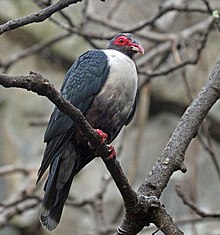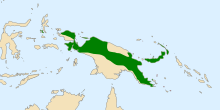Papuan mountain pigeon
| Papuan mountain pigeon | |
|---|---|

| |
| Scientific classification | |
| Domain: | Eukaryota |
| Kingdom: | Animalia |
| Phylum: | Chordata |
| Class: | Aves |
| Order: | Columbiformes |
| Family: | Columbidae |
| Genus: | Gymnophaps |
| Species: | G. albertisii
|
| Binomial name | |
| Gymnophaps albertisii Salvadori, 1874
| |

| |
| Synonyms | |
| |
The Papuan mountain pigeon (Gymnophaps albertisii) is a
The Papuan mountain pigeon is
Taxonomy and systematics
The Papuan mountain pigeon was
The Papuan mountain pigeon is one of four species in the mountain pigeon
- G. a. albertisii nominate subspecies, it is found on Yapen, New Britain, New Ireland, Fergusson Island, Goodenough Island, and the mountains of New Guinea.[7][9]
- G. a. exsul Hartert, 1903:[10] It is found on the Bacan Islands. Individuals are larger and darker than those of the nominate subspecies, while the head is entirely slate in color, without the chestnut-maroon chins, throats, and ears of nominate males.[6][9]
Description

The Papuan mountain pigeon is a medium-sized pigeon that is 33–36 cm (13–14 in) long and weighs 259 g (9.1 oz) on average. It has a slender appearance with a long tail and wings. Adult males of the nominate subspecies have head and upperparts slate-grey, with chestnut-maroon throats and bellies, whitish breasts, and grey undertail coverts. There is a pale grey terminal band on the tail. The lores and orbital region are bright red, while the bill is pink with a reddish base. The feet are purplish to pinkish-red. Females may have greyish breasts and grey edges to the throat feathers. Juveniles are duller, with dull brown or grey breasts, pale rufous underparts, and chestnut foreheads.[6][9]
Pinon's imperial pigeon looks similar to a juvenile Papuan mountain pigeon, but is larger, more heavily built, has a darker bill, and does not have the red of the orbital skin extending to the lores.[6]
Vocalisations
The Papuan mountain pigeon is usually silent, but gives a muted, low-pitched, upslurred wooooooo m or woom during the breeding season. It also makes soft whistles.[6][9]
Distribution and habitat
The Papuan mountain pigeon is found on New Guinea, its surrounding islands, and the Bacan Islands. It is mainly found in
The Papuan mountain pigeon is thought to be partially migratory, with large flocks in the Schrader Range descending to visit beech forests during the rainy season from October to March. It also moves to lower altitudes while foraging.[6][9]
Behaviour and ecology
The Papuan mountain pigeon is a highly social species, occurring in flocks that usually contain 10–40 birds and that can sometimes have up to 80 individuals. It is also less commonly seen singly or in pairs. Individuals usually roost at high elevations, and then descend to lower elevations in flocks in the morning. While doing so, they can drop hundreds of metres in a single dive, producing a loud whooshing sound that is distinctive of Gymnophaps pigeons. While leaving the roost, flocks fly just above the treetops, but begin flying higher when crossing lowlands, sometimes flying high enough to be barely visible to the naked eye.[6][9]
Diet

The Papuan mountain pigeon is
Breeding
From July to December, as well as in April, male Papuan mountain pigeons have been observed performing display flights. One or two males consort with a female from an open perch overlooking a steep drop, after which one male launches himself and dives down before suddenly rising 25–30 m (82–98 ft) above the forest canopy with rapid wingbeats. The male then stalls at the top of this rise and plummets again before returning to his perch. This is repeated periodically, with both males taking turns to display to the female. The display has only been recorded in the early morning and late afternoon.[6]
The Papuan mountain pigeon breeds from October to March in the Schrader Range, but a juvenile and an adult male with enlarged testicles have been collected in June elsewhere, suggesting that the species may breed throughout the year across its range. Nesting is thought to be partially colonial. Early in the wet season, the species nests in low, sheltered areas, but nests in higher, more exposed areas towards the end. The nest is usually a platform of sticks and twigs built on a small tree at a height of 3.7–5 m (12–16 ft), but may be placed higher. A ground nest built in a depression in short dry grass has also been observed above the tree line. It lays a single white egg.[6][9][14]
Parasites and predators
A 2021 study examining specimens of the Papuan mountain pigeon for the presence of
Status
The Papuan mountain pigeon is listed as being of least concern by the International Union for Conservation of Nature (IUCN) on the IUCN Red List due to its large range and lack of significant population decline. The population of the species has not been determined, but is thought to be stable.[1] It is widely distributed and common on New Guinea, although local populations can vary widely. It is generally uncommon on New Britain and New Ireland, but is apparently very common in lowland forest and secondary forest on the former. The subspecies exsul from Bacan is thought to be uncommon, and its current status is unknown.[6][9] It is locally hunted in New Guinea.[13]
Explanatory notes
- ^ A binominal authority in parentheses indicates that the species was originally described in a genus other than Gymnophaps.
References
- ^ . Retrieved 2021-11-11.
- ^ Salvadori, Tommaso (1874). "Altre nuove specie di uccelli della Nuova Guinea e di Goram raccolto dal Signor L. M. L'Albertis" [Other new species of birds of New Guinea and of Goram collected by Mr. L. M. L'Albertis]. Annali del Museo civico di storia naturale di Genova (in Italian). Vol. 6. Genoa: Tip. del R. Istituto Sordo-Muti. pp. 86–87. Archived from the original on 2021-11-08. Retrieved 2021-11-08 – via Biodiversity Heritage Library.
- ^ a b c d Gill, Frank; Donsker, David; Rasmussen, Pamela (eds.). "Pigeons". IOC World Bird List. Archived from the original on 2021-10-19. Retrieved 2021-11-08.
- ISBN 978-1-4081-2501-4.
- ^ "Gymnophaps albertisii (Papuan Mountain-Pigeon)". Avibase. Archived from the original on 2021-10-27. Retrieved 2021-11-08.
- ^ OCLC 701718514.
- ^ OCLC 936447561.
- from the original on 2021-11-09. Retrieved 2022-02-10.
- ^ S2CID 243173287. Retrieved 2021-11-08.
- ^ Hartert, Ernst (1903-04-20). "The Birds of Batjan". Novitates Zoologicae. X (2): 60. Retrieved 2022-05-30 – via Biodiversity Heritage Library.
- from the original on 2021-11-09. Retrieved 2022-02-10.
- from the original on 2022-02-10. Retrieved 2022-02-10.
- ^ from the original on 2021-11-09. Retrieved 2022-02-10.
- from the original on 2022-02-10. Retrieved 2022-02-10.
- PMID 34944169.
- from the original on 2022-02-10. Retrieved 2022-02-10.
- from the original on 2021-11-09. Retrieved 2022-02-10.
External links
 Media related to Gymnophaps albertisii at Wikimedia Commons
Media related to Gymnophaps albertisii at Wikimedia Commons Data related to Gymnophaps albertisii at Wikispecies
Data related to Gymnophaps albertisii at Wikispecies

